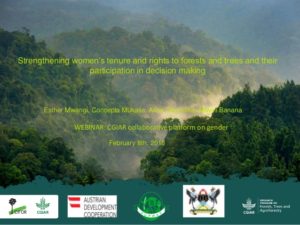The year 2018 saw the CGIAR Research Program on Forests, Trees and Agroforestry (FTA) chalk up some notable achievements in the worlds of sustainable development, food security and addressing climate change.

A number of the program’s research findings reverberated throughout the scientific community, impacting discussions at major events and informing work on the ground.
Read on to find out which news articles, research publications, presentations and videos were most-viewed on the FTA website throughout the year.
Gender, agroforestry and combating deforestation were strong points of interest among news articles, topped off by research on orphan crops – underutilized crops that are being brought out of the shadows by plant breeding – which was also covered by The Economist and the Financial Times. The 10 most-viewed news articles on the FTA website in 2018 are as follows.
- Orphan crops for improving diets
- The power of science to halt deforestation
- Climate change atlas presents suitability maps for agroforestry species in Central America
- Halting deforestation is ‘everyone’s fight’
- FTA’s research domain on livelihood systems receives strong rating
- Picks and spades can triple farmers’ yields in Kenyan drylands
- Good investments in agriculture and forestry can benefit smallholders and landscapes
- Innovation and excellence from chocolate producers
- Agroforestry offers pathways to sustainable landscape restoration
- Woman on a mission: Pushing for rights and a seat at the decision-making table

Research publications are of course not only viewed via the FTA website but also via the websites of partner institutions or scientific journals.
Of those collated on the FTA website, however, the top 10 most-viewed encompassed ecosystem services, value chains and climate, along with the relationship between trees and water – a popular topic that was the subject of a two-day symposium in 2017 and a follow-up discussion forum in 2018:
- Co-investment in ecosystem services: global lessons from payment and incentive schemes
- Analysis of gender research on forest, tree and agroforestry value chains in Latin America
- Decision support tools for forest landscape restoration: Current status and future outlook
- Certifying Environmental Social Responsibility: Special Issue
- Suitability of key Central American agroforestry species under future climates: an atlas
- Landscape Restoration in Kenya: Addressing gender equality
- Forest ecosystem services and the pillars of Bhutan’s Gross National Happiness
- Tropical forest-transition landscapes: a portfolio for studying people, tree crops and agro-ecological change in context
- Trees, forests and water: Cool insights for a hot world
- Bridging molecular genetics and participatory research: how access and benefit-sharing stimulate interdisciplinary research for tropical biology and conservation

As always, FTA scientists presented their work to colleagues and to broader audiences at workshops and events around the world. The top 10 most-viewed presentations of those collected on the FTA website looked at governance, REDD+ and tenure.
- Comparing governance reforms to restore the forest commons in Nepal, China and Ethiopia
- A personal take on forest landscapes restoration in Africa
- Strengthening women’s tenure and rights to forests and trees and their participation in decision making
- Are there differences between men and women in REDD+ benefit sharing schemes?
- Conflict in collective land and forest formalization: a preliminary analysis
- Implications of the ASEAN Economic Community (AEC) for trans-boundary agricultural commodities, forests and smallholder farmers
- Reconciling policy and practice in the co-management of forests in indigenous territories
- Informing gender-responsive climate policy and action
- Assessing REDD+ readiness to maximize climate finance impact
- Forest policy reform to enhance smallholder participation in landscape restoration: The Peruvian case

FTA’s partner institutions produced compelling video content in 2018, drawing in viewers interested in drones, nutrition, landscapes and more. The top 10 most-viewed videos posted on the FTA website are as follows.
- Agroforestry in landscape restoration for livelihoods, climate and ecosystem services
- Drone technology for science
- Daniel Murdiyarso talks about the interaction between land and oceans
- Expansion of oil palm plantations into forests appears to be changing local diets in Indonesia
- Lessons learned from REDD+: progress in 8 countries and the way forward
- Restoring landscapes, respecting rights
- Creating a movement on sustainable landscapes
- Developing and applying an approach for the sustainable management of landscapes
- Social inclusion, equity and rights in the context of restoration – lessons from the ground
- Integrated landscapes approaches: From theory to practice
Finally, a special mention goes to a well-received infographic from FTA’s gender team: Gender matters in forest landscape restoration.
As the program forges ahead into 2019, it expects to see a continued presence at high-level events and even wider dissemination of its work, in line with its innovative research projects ongoing around the world to further the contributions of forests, trees and agroforestry to sustainable development.











